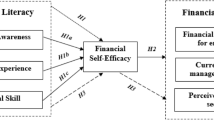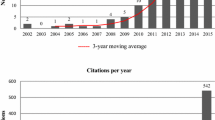Abstract
Investment in the securities markets is vital to households’ wealth accumulation and financial security. Using data from the 2008 Survey of Chinese Consumer Finance and Investor Education, we found that self-assessed investment knowledge and having a long-term financial plan were positively associated with Chinese households’ participation in the securities markets. The findings provide insight into the long-term financial security of Chinese households. Given the growing middle class and the rapid development of the financial markets in China, the Chinese financial planning industry is likely to grow substantially in the coming years.
Similar content being viewed by others
Notes
Ideally, it would be informative to know the specific amounts held in each type of security. However, financial information in the SCCFIE was collected in the form of categorical variables and so it was not possible to determine the specific amounts held.
For a detailed description of the data, see Liao et al. (2010).
Note that the geographical information was not included in our dataset.
Hilgert et al. (2003) explored the link between financial knowledge and behavior, focusing on four broad categories of financial practices: cash-flow management, credit management, savings, and investments. They found financial knowledge in specific areas to be positively correlated with financial practices in those areas. We also expect to find a positive relationship such that greater financial planning understanding is likely to result in more sophisticated and complex financial investments.
At the time of the survey interview, the exchange rate was about 6.83 Chinese Yuan to 1 US dollar.
In China, the typical retirement age is 50 for women and 55 for men, except for government employees whose retirement age is 60 regardless of gender.
References
Allgood, S., & Walstad, W. (2013). Financial literacy and credit card behaviors: A cross-sectional analysis by age. Numeracy, 6(2), 3.
Ameriks, J., Caplin, A., & Leahy, J. (2003). Wealth accumulation and the propensity to plan. The Quarterly Journal of Economics, 118(3), 1007–1047. doi:10.1162/00335530360698487.
Babiarz, P., & Robb, C. A. (2014). Financial literacy and emergency saving. Journal of Family and Economic Issues, 35(1), 40–50. doi:10.1007/s10834-013-9369-9.
Benzoni, L., Collin-Dufresne, P., & Goldstein, R. S. (2007). Portfolio choice over the life cycle when the stock and labor markets are cointegrated. The Journal of Finance, 62(5), 2123–2167. doi:10.1111/j.1540-6261.2007.01271.x.
Bertaut, C. C. (1998). Stockholding behavior of US households: Evidence from the 1983–1989 Survey of Consumer Finances. Review of Economics and Statistics, 80(2), 263–275. doi:10.1162/003465398557500.
Bertaut, C., & Starr-McCluer, M. (2000). Household portfolios in the United States. FEDS Working Paper, No. 2000-26. Washington, DC: Board of Governors of the Federal Reserve System. doi:10.2139/ssrn.234154.
Brandon, E. D, Jr, & Welch, H. O. (2009). The history of financial planning: The transformation of financial services. Hoboken, NJ: Wiley.
Bruce, K., Ahmed, A., & Huntly, H. (2011). An approach to understanding the professionalism of financial planners. Journal of Business Systems, Governance and Ethics, 6(3), 1. doi:10.15209/jbsge.v6i3.205.
Campbell, J. (2006). Household finance. Journal of Finance, 61, 1553–1604. doi:10.1111/j.1540-6261.2006.00883.x.
Chamon, M. D., & Prasad, E. S. (2010). Why are saving rates of urban households in China rising? American Economic Journal: Macroeconomics, 2(1), 93–130. doi:10.1257/mac.2.1.93.
Claessens, S., & Glaessner, T. C. (1999). Internationalization of financial services in Asia (No. 1911). Washington, DC: World Bank, Poverty Reduction and Economic Management Network, Economic Policy Division. doi:10.1596/1813-9450-1911.
Cocco, J. F., Gomes, F. J., & Maenhout, P. J. (2005). Consumption and portfolio choice over the life cycle. Review of Financial Studies, 18(2), 491–533. doi:10.1093/rfs/hhi017.
Davies, J. B., Sandström, S., Shorrocks, A., & Wolff, E. N. (2011). The Level and distribution of global household wealth. The Economic Journal, 121(551), 223–254. doi:10.1111/j.1468-0297.2010.02391.x.
Didier, T., & Schmukler, S. L. (2014). Financial development in Asia: Beyond aggregate indicators. World Bank Policy Research Working Paper, No. 6761. Washington, DC: The World Bank. doi:10.1596/1813-9450-6761.
Farrell, D., Gersch, U. A., & Stephenson, E. (2006). The value of China’s emerging middle class. McKinsey Quarterly, 2(1), 60–69.
Financial Planning Standards Board. (2015). CFP professionals infographic. Retrieved from https://www.fpsb.org/component/content/article/538.html.
Gan, L., Yin, Z., Jia, N., Xu, S., Ma, S., & Zheng, L. (2014). Data you need to know about China: Research report of China Household Finance Survey 2012. Berlin: Springer. doi:10.1007/978-3-642-38151-5.
He, X., Shi, W., & Zhou, K. (2009). Background risk and investors’ participation in risky financial assets. Economic Research Journal, 12, 119–130. in Chinese.
Heaton, J., & Lucas, D. (2000). Portfolio choice and asset prices: The importance of entrepreneurial risk. The Journal of Finance, 55(3), 1163–1198. doi:10.1111/0022-1082.00244.
Hilgert, M. A., Hogarth, J. M., & Beverly, S. (2003). Household financial management: The connection between knowledge and behavior. Federal Reserve Bulletin, 89, 309–322.
Keister, L. A. (2000). Race and wealth inequality: The impact of racial differences in asset ownership on the distribution of household wealth. Social Science Research, 29(4), 477–502. doi:10.1006/ssre.2000.0677.
Kimball, M., & Shumway, T. (2010). Investor sophistication and the participation, home bias, diversification, and employer stock puzzles. Unpublished Manuscript, University of Michigan. doi: 10.2139/ssrn.1572866.
Larsen, C. (2011, June 1). FPA in China: How the Chinese invest now and for retirement. ThinkAdvisor. Retrieved from http://www.thinkadvisor.com/2011/06/01/fpa-in-china-how-the-chinese-invest-now-and-for-re?page_all=1.
Ledgerwood, J., Earne, J., & Nelson, C. (Eds.). (2013). The new microfinance handbook: A financial market system perspective. Washington, DC: World Bank Publications. doi:10.1596/978-0-8213-8927-0.
Li, X., Xiao, B., Yu, H., & Song, J. (2011). Survey of household finance. Journal of Management Sciences in China, 14(4), 74–85. in Chinese.
Liao, L., Huang, N., & Yao, R. (2010). Family finances in urban China: Evidence from a national survey. Journal of Family and Economic Issues, 31(3), 259–279. doi:10.1007/s10834-010-9218-z.
Lu, J., & Gu, J. (2009). Analysis on the influencing factors in household financial portfolio selection—Evidence From Nanjing, Jiangsu province. Journal of Financial Development Research, 10, 25–29. [in Chinese].
Lusardi, A. (1999). Information, expectations, and savings for retirement. In H. J. Aaron (Ed.), Behavioral dimensions of retirement economics (pp. 81–115). Washington, DC: Brookings Institution Press.
Lusardi, A. (2001). Explaining why so many people do not save. Center for Retirement Research at Boston College, Working Paper No. 2001-05. Chestnut Hill, MA: Center for Retirement Research at Boston College. doi:10.2139/ssrn.285978.
Lusardi, A., Michaud, P. C., & Mitchell, O. S. (2011). Optimal financial literacy and saving for retirement. SSRN Electronic Journal,. doi:10.2139/ssrn.1978960.
Lusardi, A., Michaud, P. C., & Mitchell, O. S. (2013). Optimal financial knowledge and wealth inequality (No. w18669). National Bureau of Economic Research. doi:10.3386/w18669.
Lusardi, A., & Mitchell, O. S. (2007). Baby boomer retirement security: The roles of planning, financial literacy, and housing wealth. Journal of Monetary Economics, 54(1), 205–224. doi:10.1016/j.jmoneco.2006.12.001.
Marsden, M., Zick, C. D., & Mayer, R. N. (2011). The value of seeking financial advice. Journal of Family and Economic Issues, 32(4), 625–643. doi:10.1007/s10834-011-9258-z.
Meng, X. (2003). Unemployment, consumption smoothing, and precautionary saving in urban China. Journal of Comparative Economics, 31(3), 465–485. doi:10.1016/S0147-5967(03)00069-6.
Powell, M., & Ansic, D. (1997). Gender differences in risk behaviour in financial decision-making: An experimental analysis. Journal of Economic Psychology, 18(6), 605–628. doi:10.1016/S0167-4870(97)00026-3.
Qin, D. (2003). Determinants of household savings in China and their role in quasi-money supply. Economics of Transition, 11(3), 513–537. doi:10.1111/1468-0351.00161.
Qin, X., & Ren, R. (2008). Comparable household saving rates for China and the United States. Review of Income and Wealth, 54(4), 656–670. doi:10.1111/j.1475-4991.2008.00294.x.
Robb, C. A., Babiarz, P., & Woodyard, A. (2012). The demand for financial professionals’ advice: The role of financial knowledge, satisfaction, and confidence. Financial Services Review, 21(4), 291–305.
Robb, C. A., & Woodyard, A. S. (2011). Financial knowledge and ‘best practice’ behavior. Journal of Financial Counseling and Planning, 22(1), 36–46.
Sharpe, D. L., Yao, R., & Liao, L. (2012). Correlates of credit card adoption in urban China. Journal of Family and Economic Issues, 33(2), 156–166. doi:10.1007/s10834-012-9309-0.
Shefrin, H. M., & Thaler, R. H. (1988). The behavioral life-cycle hypothesis. Economic Inquiry, 26(4), 609–643.
Sundén, A. E., & Surette, B. J. (1998). Gender differences in the allocation of assets in retirement savings plans. American Economic Review, 88(2), 207–211. Retrieved from http://www.jstor.org/stable/116920.
Tam, O. K. (Ed.). (2013). Financial reform in China. New York: Routledge.
Van Rooij, M., Lusardi, A., & Alessie, R. (2011). Financial literacy and stock market participation. Journal of Financial Economics, 101(2), 449–472. doi:10.1016/j.jfineco.2011.03.006.
Wang, C., & Tian, C. (2012). Stock market participation, participation rate and determinants. Economic Research Journal, 10, 97–107. [in Chinese].
Xiao, J. J., Tang, C., Serido, J., & Shim, S. (2011). Antecedents and consequences of risky credit behavior among college students: Application and extension of the theory of planned behavior. Journal of Public Policy and Marketing, 30(2), 239–245. doi:10.1509/jppm.30.2.239.
Xu, Y., Beller, A. H., Roberts, B. W., & Brown, J. R. (2015). Personality and financial outcomes. Working paper, University of Illinois.
Zhao, C. (2012, April). Development of Chinese government bonds in the secondary market, issues and policy recommendations. China Bond, 19–23. [in Chinese].
Acknowledgments
The authors would like to thank Angela Lyons for her contribution to this paper.
Author information
Authors and Affiliations
Corresponding author
Rights and permissions
About this article
Cite this article
Yao, R., Xu, Y. Chinese Urban Households’ Security Market Participation: Does Investment Knowledge and Having a Long-Term Plan Help?. J Fam Econ Iss 36, 328–339 (2015). https://doi.org/10.1007/s10834-015-9455-2
Published:
Issue Date:
DOI: https://doi.org/10.1007/s10834-015-9455-2




